Old World warblers are a large group of birds formerly grouped together in the bird family Sylviidae. They are not closely related to the New World warblers. The family held over 400 species in over 70 genera, and were the source of much taxonomic confusion. Two families were split out initially, the cisticolas into Cisticolidae and the kinglets into Regulidae. In the past ten years they have been the subject of much research and many species are now placed into other families, including the Acrocephalidae, Cettiidae, Phylloscopidae, and Megaluridae. In addition some species have been moved into existing families or have not yet had their placement fully resolved. A smaller number of warblers, together with some babblers formerly placed in the family Timaliidae and the parrotbills, are retained in a much smaller family Sylviidae.

The cuckoo, common cuckoo, European cuckoo or Eurasian cuckoo is a member of the cuckoo order of birds, Cuculiformes, which includes the roadrunners, the anis and the coucals.

The Old World babblers or Timaliidae are a family of mostly Old World passerine birds. They are rather diverse in size and coloration, but are characterised by soft fluffy plumage. These are birds of tropical areas, with the greatest variety in Southeast Asia and the Indian subcontinent. The timaliids are one of two unrelated groups of birds known as babblers, the other being the Australasian babblers of the family Pomatostomidae.

The tawny-bellied babbler also known in older Indian works as the rufous-bellied babbler is a small babbler that forages in small groups in low scrub forests. Like other members of the large Old World babbler family they are passerine birds characterised by soft fluffy plumage. There are three subspecies within the Indian Subcontinent. The nominate hyperythra found in northern and eastern India is uniformly brown underneath while albogularis of the western Indian peninsula is white throated. The population in Sri Lanka, phillipsi, is also white throated but is paler underneath and has a larger bill.
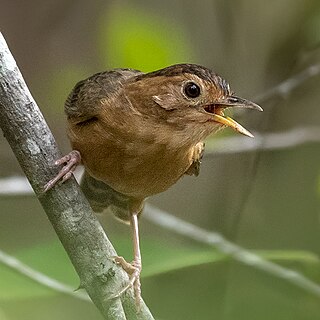
The brown-capped babbler is a member of the family Pellorneidae.

The dark-fronted babbler is an Old World babbler found in the Western Ghats of India and the forests of Sri Lanka. They are small chestnut brown birds with a dark black cap, a whitish underside and pale yellow iris. They forage in flocks in the undergrowth of forests constantly making calls and uttering alarm calls when disturbed.

Turdoides is a genus of passerine birds in the laughingthrush family Leiothrichidae. The species are distributed across Africa and southern Asia and are typically fairly large, long-tailed birds which forage in noisy groups. The majority of species have drab brown or grey-brown plumage. Several species that were included in Turdoides in the past have been reassigned to Argya following a 2018 study that found multiple clades.

Pellorneum is a genus of passerine birds in the family Pellorneidae. Some of its species were formerly placed in the genus Trichastoma.

The Javan black-capped babbler is a species of bird in the family Pellorneidae. It is endemic to the island of Java in Indonesia. The Malayan black-capped babbler and the Bornean black-capped babbler were both formerly considered conspecific, but were split from it in 2021. Its natural habitat is subtropical or tropical moist lowland forest.
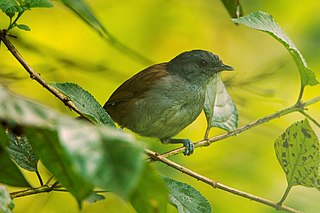
The African hill babbler is a species of bird in the family Sylviidae.

The rufous-capped babbler is a babbler species in the family Timaliidae. It occurs from the Eastern Himalayas to northern Thailand, Laos, eastern China to Vietnam and Taiwan. It inhabits temperate forest with dense bushes or bamboo and is listed as Least Concern on the IUCN Red List.

Sylvioidea is a superfamily of passerine birds, one of at least three major clades within the Passerida along with the Muscicapoidea and Passeroidea. It contains about 1300 species including the Old World warblers, Old World babblers, swallows, larks and bulbuls. Members of the clade are found worldwide, but fewer species are present in the Americas.
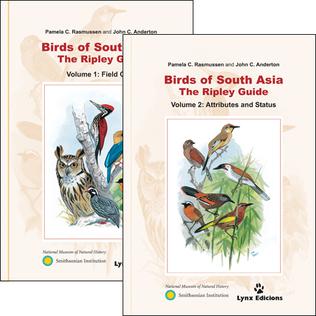
Birds of South Asia: The Ripley Guide by Pamela C. Rasmussen and John C. Anderton is a two-volume ornithological handbook, covering the birds of South Asia, published in 2005 by the Smithsonian Institution and Lynx Edicions. The geographical scope of the book covers India, Bangladesh, Pakistan, Sri Lanka, Nepal, Bhutan, Maldives, the Chagos Archipelago and Afghanistan. In total, 1508 species are covered. Two notable aspects of Birds of South Asia are its distribution evidence-base — the book's authors based their distributional information almost completely on museum specimens — and its taxonomic approach, involving a large number of species-level splits.

The jungle babblers are a family, Pellorneidae, of mostly Old World passerine birds belonging to the superfamily Sylvioidea. They are quite diverse in size and coloration, and usually characterised by soft, fluffy plumage and a tail on average the length of their body, or longer. These birds are found in tropical zones, with the greatest biodiversity in Southeast Asia and the Indian subcontinent.
Papikonda National Park is a national park in India, located near Rajamahendravaram in the Papi Hills of the Alluri Sitharama Raju and Eluru districts of Andhra Pradesh, and covering an area of 1,012.86 km2 (391.07 sq mi). It is an Important Bird and Biodiversity Area and home to some endangered species of flora and fauna. No part of Papikonda remains outside East and West Godavari districts after 2014 and the construction of Polavaram Dam.
The Rwenzori hill babbler is a species of passerine bird in the family Sylviidae that is found in Africa.
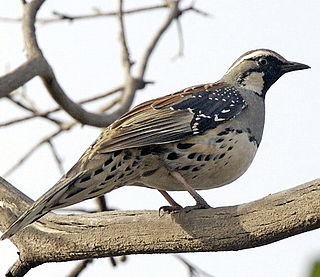
Cinclosomatidae is a family of passerine birds native to Australia and New Guinea. It has a complicated taxonomic history and different authors vary in which birds they include in the family. It includes the quail-thrushes and jewel-babblers.
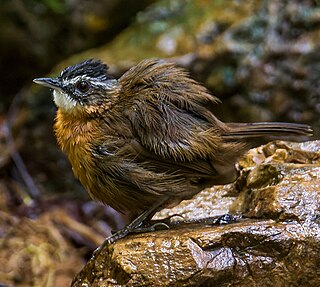
The Malayan black-capped babbler is a species of bird in the family Pellorneidae. It is found on the Malay Peninsula, Sumatra, Bangka Island, Belitung and North Natuna. This species, the Javan black-capped babbler and the Bornean black-capped babbler were formerly considered conspecific, but were split from it in 2021. Together they were called the black-capped babbler. Its natural habitat is subtropical or tropical moist lowland forest.














